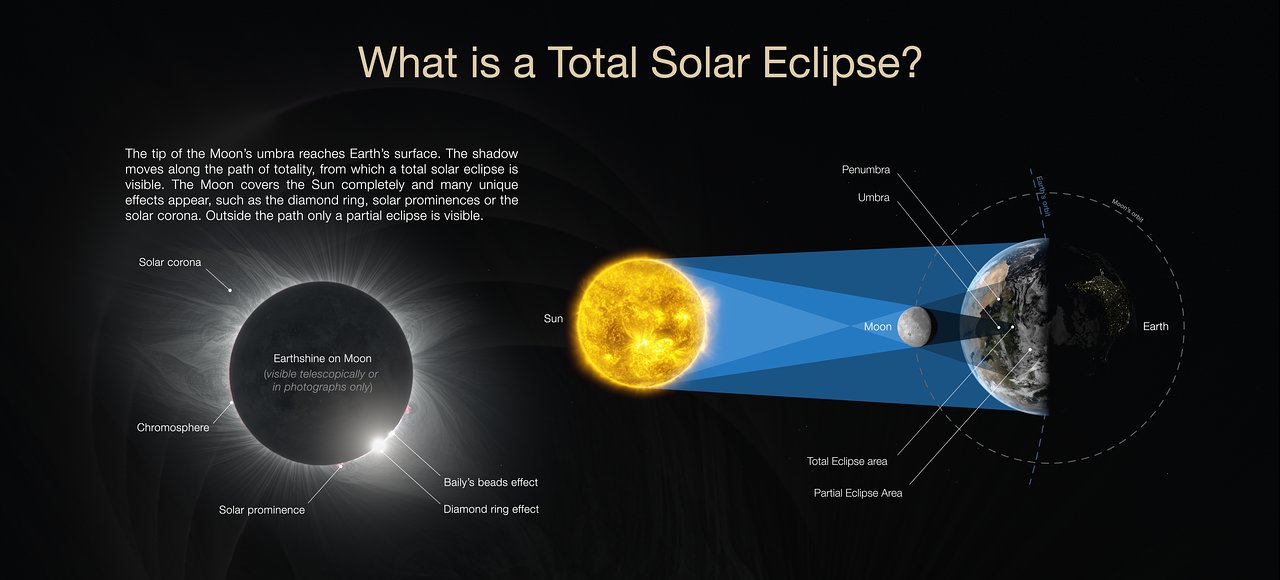2019
#MeetESO – how does a solar eclipse occur?

Tomorrow, my trip to Chile starts. A plane will take me from Rome in about 16 hours to Santiago de Chile, were I will meet my MeetESO buddies. On Monday, 1st July we will then travel by bus to our first destination: The European Southern Observatories in La Silla. This year marks the 50th anniversary of the observatory and on this occasion a total solar eclipse will happen 😉. Solar eclipses are relatively frequent (1-2 eclipses per year), but visible only on different regions on Earth. Rather seldom, an eclipse occurs at a major astronomical observatory (e.g. in 1991 a solar eclipse at Mauna Kea observatory). Therefore, its only logical that astronomers have prepared special experiments for the eclipse in Chile.

How does a solar eclipse occur?
When Sun, Moon and Earth align in a straight line, then the Moon can occult the Sun. As the Moon’s orbit is tilted about 5° to the ecliptic – this is the orbital plane of the Earth around the sun – a solar eclipse doesn’t happen every New Moon. Solar eclipse can only be seen on narrow areas on Earth, because the Moon is too small to cover the sun for the whole Earth hemisphere.
The more complex explanation: A solar eclipse happens when the synodic, draconic and anomalistic periods coincide. That means the Moon must be in the synodic month a new Moon, for the draconic month the Moon must be near one of the two lunar (draconic) nodes (these are intersections of the Moon orbit with the ecliptic) and as for the anomalistic month, the Moon has to be on the same point in his orbit again.
Every 6585 days, which equals about 18 years, the Moon will be again in the same place, when the three periods are in a harmonic. This period is also called Saros series. – By the way, the solar eclipse on 02 July 2019 is part of Saros series no. 127.
Fun fact: the name of the draconic node is referencing a picture of a dragon, who is gulping the Sun during an eclipse – according to ancient Chinese astronomers.

What types of solar eclipse exist?
- Total eclipse: The Moon covers the Sun completely. In Austria, the latest total solar eclipse occurred on 11. August 1999. Only with this type of solar eclipse the solar corona can be seen with naked eye
- Annular eclipse: The Moon does not cover the Sun completely. As the Earth and the Moon do have elliptic orbits, the Moon can be farther away. Then, the apparent size of the Moon is smaller, so it cannot cover the Sun in total.
- Hybrid eclipse: This is an annular & total eclipse at the same time. At the beginning and/or end of the eclipse always an annular eclipse is visible, which then changes to a total eclipse. The totality is usually very short. This type of an eclipse is very rare.
- Partial eclipse: During a total eclipse the totality zone is very small. Joining is always the penumbra area, where the Moon covers the Sun only partially. This area is much bigger than the actual totality zone.
Solar eclipses are a perfect opportunity for astronomers and solar physicists to examine the corona of the Sun and to perform special experiments. A very famous test, the Eddington experiment, was conducted during the solar eclipse on the 29. May 1919. Einstein’s prediction of the gravitational deflection of light was confirmed, which was postulated in his General Relativity.
Solar eclipses are a perfect opportunity for astronomers and solar physicists to examine the corona of the Sun and to perform special experiments. A very famous test, the Eddington experiment, was conducted during the solar eclipse on the 29. May 1919. Einstein’s prediction of the gravitational deflection of light was confirmed, which was postulated in his General Relativity.
More about this experiment and how this historic experiment plays a role at the 2019 La Silla eclipse, will be covered in my next blog post.
Source / Further information:
- https://de.wikipedia.org/wiki/Sonnenfinsternis
- https://de.wikipedia.org/wiki/Saroszyklus
- https://de.wikipedia.org/wiki/Mondbahn#Bahnperioden
Dieser Artikel ist auch verfügbar auf: German
- Tagged: #MeetESO, La Silla, Solar eclipse, trip
Events
Blog categories
- AMADEE-15 Simulation (13)
- AMADEE-18 (19)
- AMADEE-20 (21)
- AMADEE-24 (7)
- Aouda Spacesuit Simulator (67)
- ASE 2016 (9)
- Book tips (1)
- Events (32)
- Expeditions/Simulations (81)
- Flight projects (13)
- Guest blogs (14)
- Internships at the OeWF (48)
- OeWF News (342)
- Phileas rover (21)
- Press Releases (34)
- Research/Projects (129)
- Serenity spacesuit (3)
- World Space Week (25)

